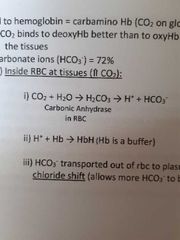![]()
![]()
![]()
Use LEFT and RIGHT arrow keys to navigate between flashcards;
Use UP and DOWN arrow keys to flip the card;
H to show hint;
A reads text to speech;
31 Cards in this Set
- Front
- Back
|
Plateau rang of O2 Hb dissociation curve |
60-100mmHg Therefore I alveolar PO2 a little below normal there is little change in Hb saturation |
|
|
Steep portion of O2- Hb dissociation curve |
Rand of Po2 in tissues, O2 unloaded |
|
|
Shift to the right in O2-HB dissociation curve |
Less Hb saturation Aka O2 unloads more easily/loads less easily Reasons: 1. increase Pco2 2. Decrease pH 3. Increase temp Increase metabolism (e.g. exercise) |
|
|
Shift to left of dissociation curve |
Hb more saturation aka. Loads easier Cause by (the conditions at the lungs) 1. Decrease Pco2 and temp 2. Increase pH |
|
|
CO2 carried in 3 ways |
1. Dissolved in plasma 8% 2. Bound to hemoglobin 20% 3. As bicarbonate (HCO3-) 72% |
|
|
CO2 levels In the plasma |
45mmHg = deoxy 40mmHg = oxygenated |
|
|
Carbamino Hb |
CO2 on hemoglobin globin |
|
|
Carbonic anhydrase in RBS |

|
|
|
HbH |
Hemoglobin and H+ Acts as a acid/base buffer |
|
|
Chloride shift |
HCO3- being transported out of RBC to plasma in exchange for Cl- (Allows more HCO3- to be made) |
|
|
Deoxy Hb |
HbH or HbCO2 |
|
|
Haldane effect |
HbO2 binds CO2 and H+ poorly, therefore CO2 is released |
|
|
2 groups of neurons at respiratory centers in Medulla |
1. Ventral respiratory groups 2. Dorsal respiratory groups |
|
|
VRG |
Generate rate Expiratory and inspiratory neurons |
|
|
DRG |
Receive chemorecpetor input and modify VRG output |
|
|
Inspiratory neurons |
Impulses down spinal cord to 1. Phrenic nerve (innervetes diaphragm) 2. Thoracic nerve(innervate ext. Intercostal) |
|
|
Expiratory neurons |
Fire to inhibit inspiration neurons (Expiration occurs passively) |
|
|
Pontine respiratory centres |
Work with medullary centers to make breathing smooth and even If damaged: gasping and irregular |
|
|
Lung stretch receptors |
In smooth muscle of bronchi and bronchioles Hering breuer reflex |
|
|
Hering breuer reflex |
Receptors overstretched on insp. Leads to Inhibit Insp. Neurons Relaxes mucles (expiration) |
|
|
Volentary control |
Primary motor cortex to skeletal muscle (bypass medulla) Medulla can override voluntary control |
|
|
Chemical control |
Via. Chemoreceptors Peripheral (carotid and aortic bodies) Central (medualla oblongata) |
|
|
Peripheral chemoreceptors |
Weakly sensitive to Pco2 Very sensitive to H+ |
|
|
Po2 of 50-60mmHg |
End of plateau of HB-O2 curve Stimulates peripheral chemoreceptors Emergency situations - often caused by lung disease or low atm Po2 |
|
|
Central chemoreceptors |
Respond indirectly to arterial Pco2 ONLY responds to H+ CSF poorly buffered so small change stim. Repsonse |
|
|
Resting arterial Pco2 |
40mmHg (37-43mmHg) |
|
|
Hyperventilation |
Decrease arterial Pco2 causes cerebral vasoconstriction Decrease Po2 to brain = dizziness |
|
|
Hypoventilation |
Increase arterial Pco2 increase H+ Causes CNS confusion |
|
|
Acidosis |
Increase H+ |
|
|
CO poisoning |
CO binds 210x stronger to Fe than O2 Resulting in decline of total O2 |
|
|
CO |
Incomplete burning of gas, coal, wood, cigarettes |

